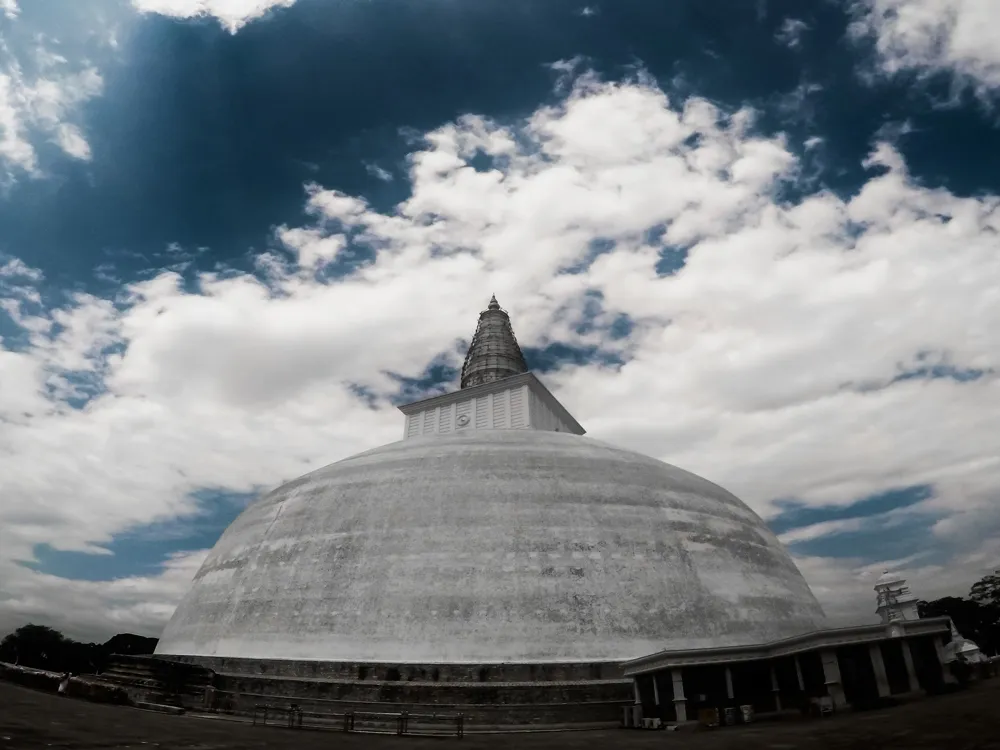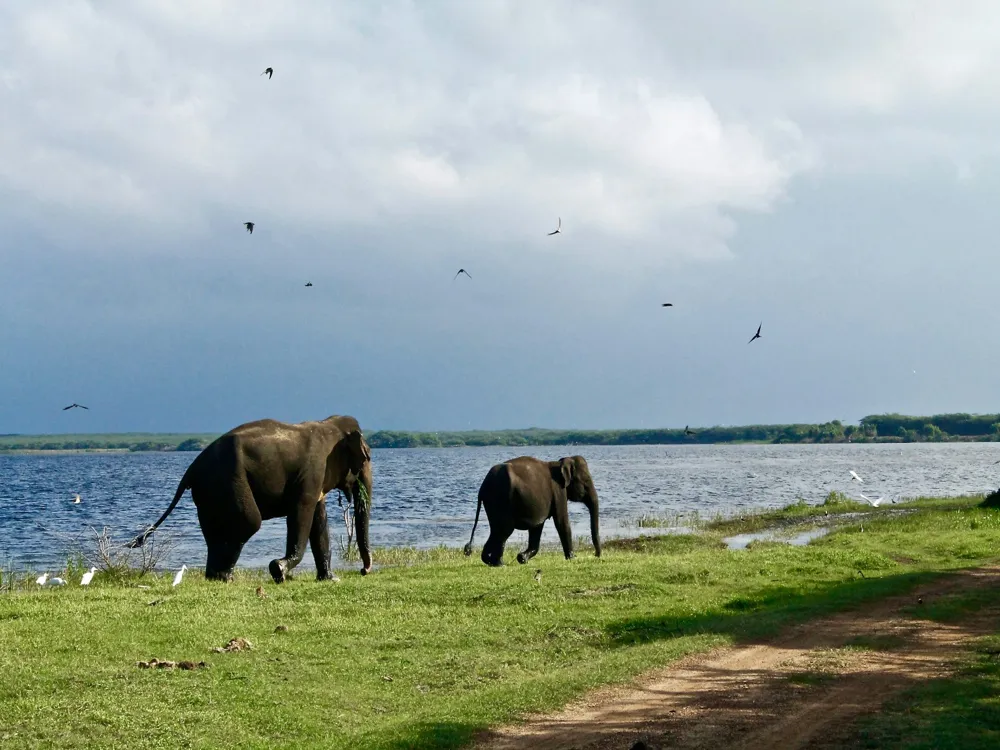Elephant Rock, situated in the serene Arugam Bay, is a natural marvel that stands as a majestic testament to the beauty of Sri Lanka’s eastern coast. This unique geological formation, resembling an elephant, has become a beacon for tourists seeking a blend of adventure and tranquility. The rock's massive structure and distinct shape make it a striking feature against the backdrop of the lush landscapes and azure waters of Arugam Bay. Visitors are often mesmerized by the panoramic views of the bay from atop the rock, especially during sunrise or sunset, making it a photographer's paradise. History intertwines with nature at Elephant Rock. Local folklore is rich with tales about this rock, contributing to the area's mystical charm. The rock has stood the test of time, witnessing the evolution of Arugam Bay from a sleepy fishing village to a bustling tourist destination. Its untouched natural beauty also serves as a reminder of the importance of preserving such sites amidst increasing tourism. The biodiversity around Elephant Rock is another aspect that draws nature enthusiasts. The surrounding area is a habitat for a variety of flora and fauna, offering glimpses of the island's rich wildlife. Birdwatchers and nature lovers often find themselves in awe of the diverse species that inhabit this region. The 'architecture' of Elephant Rock is a masterpiece of nature's design. Its imposing size and elephantine shape are the results of centuries of natural sculpting by wind, water, and weather. The rock's surface features intricate patterns and textures, telling a story of geological processes that have shaped it over time. The way the rock harmoniously blends with its surroundings is a testament to nature's artistry, making it a perfect example of organic architecture. Visitors to Elephant Rock can observe the varying hues and shades that the rock displays throughout the day. The changing position of the sun casts different shadows and highlights on its surface, creating a dynamic visual spectacle. This natural interplay of light and shadow adds to the rock's mystical aura, making every visit a unique experience. The rock formation is not only visually striking but also serves as a natural viewpoint. Its height and positioning provide a strategic vantage point for breathtaking views of the bay and the Indian Ocean. This natural elevation is a perfect spot for contemplation and appreciation of the stunning landscape that surrounds it. Plan your visit to Elephant Rock during the early morning or late afternoon to avoid the harsh midday sun. These times also offer the best light for photography. Wear comfortable shoes suitable for hiking and light, breathable clothing. The terrain can be rugged, and appropriate footwear is essential for a safe climb. Always stay on marked paths and be aware of your surroundings. The rock can be slippery, especially after rain, so exercise caution at all times. Respect the natural environment by not littering and disturbing wildlife. Carry a reusable water bottle and avoid using plastic. For the best shots, bring a camera with a good zoom lens. The unique landscape offers ample opportunities for wide-angle and panoramic photography. Elephant Rock is accessible by road from the main town of Arugam Bay. Visitors can hire a tuk-tuk or a scooter to reach the base of the rock. For those who prefer a more scenic route, a short hike through the surrounding countryside offers a chance to experience the local flora and fauna up close. The journey to Elephant Rock is an adventure in itself, revealing the rustic beauty of the eastern Sri Lankan coast. Read More:Overview of Elephant Rock, Arugam Bay
Architecture of Elephant Rock, Arugam Bay
Tips When Visiting Elephant Rock, Arugam Bay
Best Time to Visit
Footwear and Clothing
Safety Considerations
Environmental Responsibility
Photography Tips
How To Reach Elephant Rock, Arugam Bay
Elephant Rock, Arugam Bay
Arugam Bay
₹ 18,572 onwards
View arugam-bay Packages
Arugam-bay Travel Packages
View All Packages For Arugam-bay
Top Hotel Collections for Arugam-bay

Private Pool

Luxury Hotels

5-Star Hotels

Pet Friendly
Top Hotels Near Arugam-bay
Other Top Ranking Places In Arugam-bay
View All Places To Visit In arugam-bay
Faq on Arugam-bay
What is Elephant Rock in Arugam Bay?
Elephant Rock is a prominent landmark and a popular surfing spot located in Arugam Bay, Sri Lanka. It's named after its resemblance to an elephant's head and trunk.
How do you get to Elephant Rock in Arugam Bay?
To reach Elephant Rock, visitors typically take a short tuk-tuk ride or walk from Arugam Bay town. It's located just a few kilometers south of the main beach area.
Is Elephant Rock suitable for beginner surfers?
While Elephant Rock can be surfed by beginners during certain conditions, it's more commonly frequented by intermediate to advanced surfers due to its reef break and sometimes challenging waves.
What are the best times to surf at Elephant Rock in Arugam Bay?
The best surfing conditions at Elephant Rock are usually during the high season, from May to October, when the waves are consistent and the wind is offshore.
Are there any accommodations near Elephant Rock in Arugam Bay?
Yes, there are several guesthouses, surf camps, and resorts located near Elephant Rock, offering accommodation options for visitors looking to stay close to this popular surf spot.
View arugam-bay Packages
Arugam-bay Travel Packages
View All Packages For Arugam-bay
Top Hotel Collections for Arugam-bay

Private Pool

Luxury Hotels

5-Star Hotels

Pet Friendly
Top Hotels Near Arugam-bay
Other Top Ranking Places In Arugam-bay
Faq on Arugam-bay
What is Elephant Rock in Arugam Bay?
Elephant Rock is a prominent landmark and a popular surfing spot located in Arugam Bay, Sri Lanka. It's named after its resemblance to an elephant's head and trunk.
How do you get to Elephant Rock in Arugam Bay?
To reach Elephant Rock, visitors typically take a short tuk-tuk ride or walk from Arugam Bay town. It's located just a few kilometers south of the main beach area.
Is Elephant Rock suitable for beginner surfers?
While Elephant Rock can be surfed by beginners during certain conditions, it's more commonly frequented by intermediate to advanced surfers due to its reef break and sometimes challenging waves.
What are the best times to surf at Elephant Rock in Arugam Bay?
The best surfing conditions at Elephant Rock are usually during the high season, from May to October, when the waves are consistent and the wind is offshore.
Are there any accommodations near Elephant Rock in Arugam Bay?
Yes, there are several guesthouses, surf camps, and resorts located near Elephant Rock, offering accommodation options for visitors looking to stay close to this popular surf spot.














